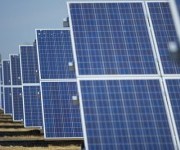 The city of Los Angeles announced a major new initiative this week to cut back on that giant sucking sound — the sound of commercial buildings hoovering up electricity.
The city of Los Angeles announced a major new initiative this week to cut back on that giant sucking sound — the sound of commercial buildings hoovering up electricity.
Two years ago, the Clinton Climate Initiative helped orchestrate a major overhaul of the Empire State Building that cut the famous spire’s energy consumption by nearly 40 percent, trimming more than $400,000 off the building’s annual energy bills. Now the Initiative has teamed up with C40, a group of cities that has committed to reducing greenhouse gas emissions, to see if they can at least start to do the same for the commercial real estate of an entire metropolis — in this case, Los Angeles.
Here’s the rub: 72 percent of the electricity generated in this country goes to heating, cooling, lighting, and otherwise powering our homes, offices, and other buildings. This accounts for a whopping 38 percent of our CO2 emissions. Tighten up those buildings by adding insulation, getting smart about heating and cooling systems, etc., and we could go a long way toward slimming down our collective ecological waistline.
Here’s the problem: This kind of work requires gobs of money. Any well-meaning homeowner knows this dilemma well: Adding insulation and weather sealing to your house will cut down on your monthly electric bill, but you just don’t have the money to pay for it up front.
To get around this roadblock, financial wizards have cooked up something called PACE financing — a trick that allows you to get a loan for the improvements up front, then pay off the debt over time by adding a few bucks to your property tax bill. You don’t feel a thing — including that breeze that used to blow in through the leaky window in your bedroom.
PACE (Property Assessed Clean Energy) has been used to fund home improvements in such havens of enlightenment as Berkeley and Sonoma County. But it has failed to take off nationwide in large part because mortgage monsters Fannie Mae and Freddie Mac gave them the big thumbs down last year.
Now, the Los Angeles Commercial Building Performance Partnership hopes to prove that these arrangements can work for commercial real estate, where owners tend to be a little more finance-savvy than your average homeowner — and are a little tighter with the folks who run the banks than you and I are.
It works like this: Using federal stimulus dollars and some added money from the state, the city offers free energy audits to folks who own commercial real estate. If they like what they see — reduced energy bills, a smaller ecological footprint, some nice P.R. for being a good corporate citizen — L.A. County will lend building owners the money to have the work done. They pay back the loan with their property tax bill over the course of up to 20 years. E voila: Commercial buildings become lean, green, energy-saving machines.
Of course, it’s a little more complicated than that. There are contracts to be signed, deals to be negotiated, and a ton of actual work to be done. But for early adopters, the Building Performance Partnership will offer a lot of hand-holding, says Sarah Potts, the L.A. city director for the Clinton Climate Initiative and C40.
“We’re looking for clear examples of how to finance energy efficiency in the commercial sector” — and not just for the Empire State Buildings of the world, but also for small “mom-and pop” businesses, Potts says. “There’s been a wariness for lenders to see this as a safe investment. We want to show that there’s a clear payback.”
The initiative aims to retrofit 20 to 30 million square feet of commercial space, including factories, hotels, offices, and retail shops. It is starting with $7.4 million in state and federal dollars, and hopes that this seed money will attract private envestment, spreading the impacts across the city. Beneficiaries will pay some money back into a pot to fund more free energy audits, planting the seeds of another crop of green buildings, and making the stimulus a gift that keeps on giving.
If it can work on the commercial front, perhaps some day it’ll fly with homes that lie outside the Berkeley city limits. In the meantime, Clinton and Co. are not the only ones doing an end-run around Fannie and Freddie by investing in commercial real estate, rather than homes. A San Francisco nonprofit, the Carbon War Room, founded by Virgin Group Chairman Richard Branson, has put together a partnership called the PACE Commercial Consortium. The consortium announced last month that it will pour $650 million into energy upgrades and retrofits in commercial spaces across the country through its Ygrene Energy Fund.
In a statement launching the initiative, Branson said the consortium “is the missing piece in the jigsaw puzzle for cities looking to implement green plans.”



